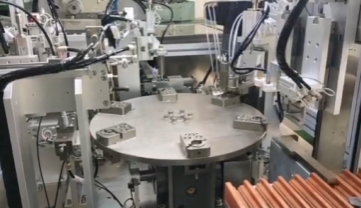What are the contents of pre-service training for employees of brushless motor motor automatic needle bearing press-in machine?
Brushless motor motor automatic needle bearing press-in machine staff pre-job training content, should cover the equipment foundation, operation specification, quality control and emergency treatment, etc., to ensure that employees can operate the equipment properly. Specific as follows:
First, the basic knowledge of equipment
Structural components: a detailed introduction to the various parts of the equipment, such as the press-in mechanism, positioning devices, transmission systems, electrical control cabinets, etc., so that employees understand its function and layout, and understand how the various parts of the work together. For example, the press-in mechanism is driven by hydraulic or electric power to precisely press the needle bearing into a specific part of the brushless motor.
Working Principle: Explain the operating principle of the equipment, including the power source, control mode and signal transmission path. Take the electric drive equipment as an example, explain how the motor converts electrical energy into mechanical energy, realizes the press-in action through the screw, guide and other devices, and how the control system controls the whole process according to the set parameters.

Second, the operation standardization process
Power on and off: Demonstrate the correct power-on sequence, such as turning on the main power supply, then turn on the equipment control power, and wait for the system to complete the self-test. When shutting down, operate in the opposite order to avoid equipment damage due to improper power failure.
Parameter setting: Teach the staff to set the appropriate parameters of indentation force, indentation speed and displacement according to different models of brushless motors and needle bearings. For example, for small motors, the indentation force may be set at 500 - 800N and the indentation speed at 5 - 10mm/s, which can be adjusted through the parameter setting area of the equipment operation interface.
Step-by-step: Demonstrate the standard operating procedure, from the placement of the brushless motor and needle roller bearings, through the initiation of the press-in process, to the removal of the finished product. Emphasize the need to ensure that the bearings and motor installation position is accurate during the operation, to avoid pressure deviation, and hands can not be close to the press-in area.
Third, quality control points
Quality standard: Define the quality judgment standard of the pressed-in products, such as the clearance between bearing and motor should be within the specified range, generally ±0.05mm, and the error of the pressed-in depth should not be more than ±0.1mm; show the difference between qualified and unqualified products through samples.
Quality Inspection: Teach employees how to use the equipment's own inspection function or external gauges (such as calipers, micrometers) to inspect the quality of pressed-in products. For example, use calipers to measure the mating dimensions of bearings and motors to test whether they meet the standards.
Fourth, the knowledge of protection
Protection risks: Point out the risks in equipment operation, such as high-pressure hydraulic oil leakage, mechanical parts pinching, electrical short circuit electric shock. To illustrate the seriousness of the risk with actual cases, such as the employee did not turn off the power to clean the equipment, fingers were pinched by running parts.
Protective measures: Introduce the use of protective devices and the role of protective devices, such as protective doors can prevent foreign objects from entering the equipment operating area, emergency brake button in case of emergency can immediately stop the equipment running. Require employees to wear protective gloves and other personal protective equipment.
V. Emergency treatment methods
Failure to determine: Train employees to identify common equipment failures, such as abnormal compression force, equipment alarm, motor does not run. Through the simulation of fault scenarios, employees learn to determine the cause of the failure according to the initial fault phenomenon, such as insufficient indentation force may be the hydraulic system oil leakage or pressure sensor failure.
Emergency operation: Teach employees the correct way to deal with malfunctions or emergencies, such as immediately pressing the emergency brake button, report to the superior and wait for professional maintenance personnel, and strictly prohibit dismantling the equipment by themselves. At the same time, employees are informed of evacuation routes and emergency assembly points in the event of a fire or other major accident.
※ If you need any help, please contact the technical specialist of Xinhui Electrical and Mechanical Equipment Co.







